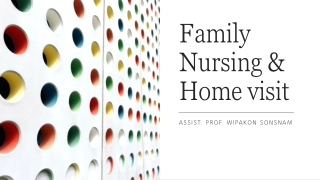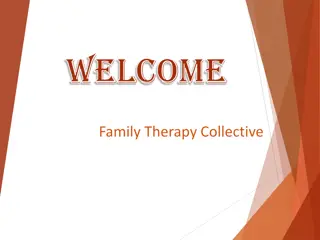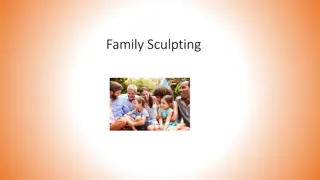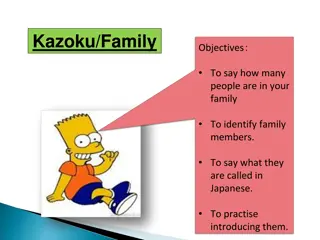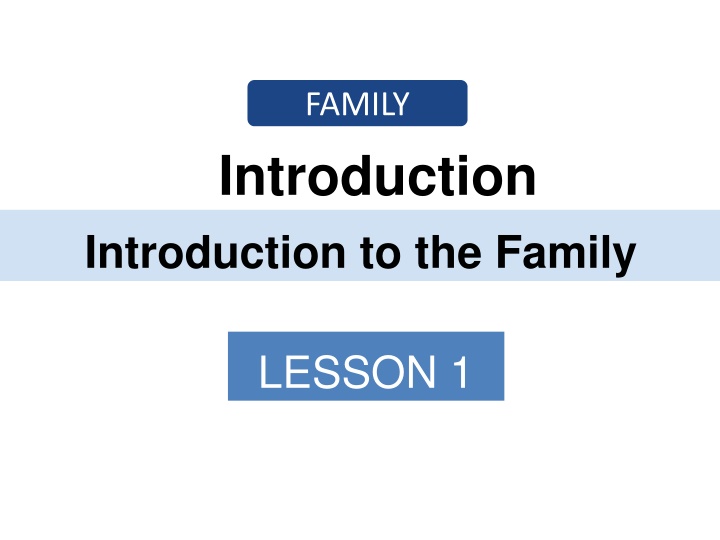
Understanding Families: Definitions and Differences Explored in Sociology Lessons
Explore the concept of family through sociology lessons, discussing definitions, differences between family and household, and real-life scenarios of family dynamics. Dive into the complexities of relationships and living arrangements within societal structures.
Download Presentation

Please find below an Image/Link to download the presentation.
The content on the website is provided AS IS for your information and personal use only. It may not be sold, licensed, or shared on other websites without obtaining consent from the author. If you encounter any issues during the download, it is possible that the publisher has removed the file from their server.
You are allowed to download the files provided on this website for personal or commercial use, subject to the condition that they are used lawfully. All files are the property of their respective owners.
The content on the website is provided AS IS for your information and personal use only. It may not be sold, licensed, or shared on other websites without obtaining consent from the author.
E N D
Presentation Transcript
FAMILY Introduction Introduction to the Family LESSON 1
CSWK: What is the family? SOME/ A*-A: I can evaluate difficulty in defining these terms today. MOST/ B: I can explain how sociologists define a family. ALL/ C: I can describe the difference between a family and household & give examples of families. KEY TERMS AND DEFINITIONS: Family a group of people related through blood. Household people who share living together but not related through blood. Do Now How many types of families can list?
Mock Examination review Look over your marks Use the Mark scheme Green Pen some of your answers
Sociologists make the distinction: List as many families, real and fictional, as you can. A family can be defined as: a group of persons directly linked by kin connections, the adult members of which assume responsibility for caring for children. Giddens A household is: a group of people, or single person, occupying a single residence. This can be a group of friend studying at university
Task 7 - Questions Decide if these are families and which are households? Man and woman living with their granddaughter Divorced mother living with her 20-year-old son Two males living with their adopted son Two 80-year-old sisters living together Three people who work together and share a flat Four students sharing a flat SOME/ A*-A: I can evaluate difficulty in defining these terms today. MOST/ B: I can explain how sociologists define a family. ALL/ C: I can describe the difference between a family and household & give examples of families.
Task 7 - answers Decide if these are families and which are households? Man and woman living with their granddaughter FAMILY Divorced mother living with her 20-year-old son FAMILY Two males living with their adopted son FAMILY Two 80-year-old sisters living together FAMILY Three people who work together and share a flat HOUSEHOLD Four students sharing a flat HOUSHOLD
Task 1 Read the extract below and discuss how he Ik view the family? The family does not feature heavily in the culture of the Ik of Northern Uganda. I fact as far as the Ik are concerned, the family means very little. This is because the Ik face a daily struggle to survive in the face of drought, famine and starvation. Anyone who cannot take care of him or herself is regarded as a useless burden by the Ik and a hazard to the survival of the others. Families mean dependants such as children who need to be fed and protected. So close to the verge of starvation, family, sentiment and love are regarded as luxuries that can mean death. Children are regarded as useless appendages, like old people, because they use up precious resources. So the old are abandoned to die. Sick and disabled children too are abandoned. The Ik attitude is that as long as you keep the breeding group alive, you can always get more children. Ik mothers throw their children out of the village compound when they are 3 years old, to fend for themselves. I imagine children must be rather relieved to be thrown out, for in the process of being cared for he or she is grudgingly carried about in a hide sling wherever the mother goes. Whenever the mother is in the field, she loosens the sling and lets the baby to the ground none too slowly, and laughs if it is hurt. Then she goes about her business, leaving the child there, almost hoping that some predator will come along and carry it off. This sometimes happens. Such behaviour does not endear children to their parents or parents to their children. S&C - Is this the same as British families?
Task 2 Who is your family? Draw or list your family tree e.g.. grandparents; aunties/uncles; brothers/sisters (their children); husband(s)/partner(s). Are they bringing up their own children?. 1. Are they still married or cohabitating (unmarried but living together). Why/why not??? 2. Do you think families have changed since you were born? How? Why? 3. Now compare your family tree to the person sat next to you, are they the same? S&c - What does this tell us about the family today? SOME/ A*-A: I can evaluate difficulty in defining these terms today. MOST/ B: I can explain how sociologists define a family. ALL/ C: I can describe the difference between a family and household & give examples of families.
In small groups use your A4 paper and markers to brainstorm: A definition of family Functions of the family Roles of particular family members Possible ideas: 1. Group who go by same rules, tradition and have the same culture. They provide support and love for each other. 2. People who love and care for each other 3. The people who raise you to be the person that you are they care and support and love you. They spend time together. 4. Bond between a group of people who care and love for each other and each have a role and responsibility 5. Who care for each other and shared a special bond and provide you with emotional support KT?
Sociologists try and define the family: Defining the family Steve Taylor (2005) The family is characterised by: Close kinship ties e.g. marriage, but increasingly "honorary kinship. Reproduction and care of children Shared experiences But there are a wide variety of families and our concept of family changes over time. Family is a social construction, i.e. it has no single definition and is defined by society.
Task 3: What is a family anyway? Watch and listen to the two clips Clip 1 On a wipeboard write down as many keywords as you can from the video https://www.youtube.com/watch?v=WyVfaB2nlao Clip 2 - On a wipeboard write down as many keywords as you can from the video https://www.youtube.com/watch?v=hpCyiyNqzlE
Task 4: I want you to imagine that you are the editor of the Oxford Dictionary. You have to create a definition to place under family . In your groups write your entry. Try to be concise. What are the keywords that you are using?
Task 5 As the family goes, so goes the nation and so goes the whole world in which we live. Pope John Paul II What do you understand by this statement? People have always placed great significance on the family (but have you ever thought about what a family actually is?). Why is the family so important? SOME/ A*-A: I can evaluate difficulty in defining these terms today. MOST/ B: I can explain how sociologists define a family. ALL/ C: I can describe the difference between a family and household & give examples of families.
Task 6 Look at the following pictures and decide whether you think they are a family or not .. SOME/ A*-A: I can evaluate difficulty in defining these terms today. MOST/ B: I can explain how sociologists define a family. ALL/ C: I can describe the difference between a family and household & give examples of families.
Clips on family types https://www.youtube.com/watch?v=ajLqOJrR LqI List the names of the different family types. https://www.youtube.com/watch?v=uasLsjdfx fk List the names of the different family types.
Task 8 Below are some family types that are found in society today. Match each up with it s correct definition One adult with children. Nuclear Extended A multi-generation extended family, in a pattern which is long and thin, with few aunts and uncles, reflecting fewer children being born in each generation, but people living longer. Contains adults from both sexes who are married with children Reconstituted Where one or both adults have been married before and have remarried. Same-sex Contains three or more generations living in the same home. Beanpole Contain two adult whose children have grown up and left. Single person Someone living on their own Empty nest ,A couple from the same sex living together Lone-parent S&C: Why are there so many different family and household types today?
Task 8 - answers Below are some family type that are found in society today. Match each up with it s correct definition One adult with children. Nuclear Extended A multi-generation extended family, in a pattern which is long and thin, with few aunts and uncles, reflecting fewer children being born in each generation, but people living longer. Contains adults from both sexes who are married with children Reconstituted Where one or both adults have been married before and have remarried. Same-sex Contains three or more generations living in the same home. Beanpole Contain two adult whose children have grown up and left. Single person Someone living on their own Empty nest ,A couple from the same sex living together Lone-parent S&C: Why are there so many different family and household types today?
Traditional Nuclear family In the UK today, people still see the nuclear family as the ideal family, especially amongst politicians. Below, are a number of characteristics identified with this type of family Children are the outcome of their parent s love. A heterosexual relationship based on romantic love. The husband provides and protects the family and is the disciplinarian. The female is concerned with motherhood and housework. S&C: Why do you think sections of society view this as the ideal family form? Why might some people dislike this family form?
Plenary Try and find 4 key terms learnt this lesson in the wordsearch below R G N V X X C D F D A I K N I N P S A H R V K U U H G D E W Y C I O O R H F T L Y H S Q A D F E H E M Y Y T E A M U R D O C K R

